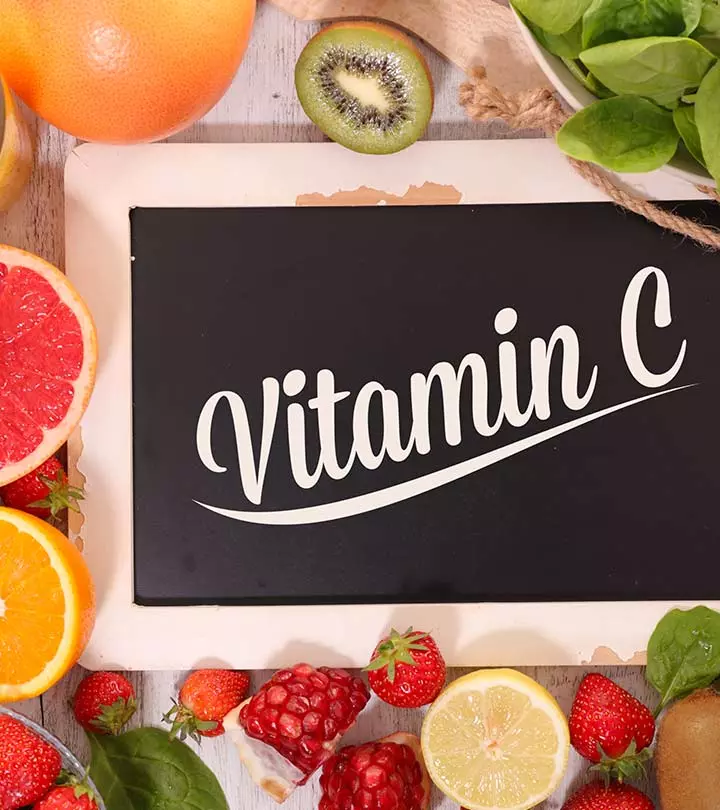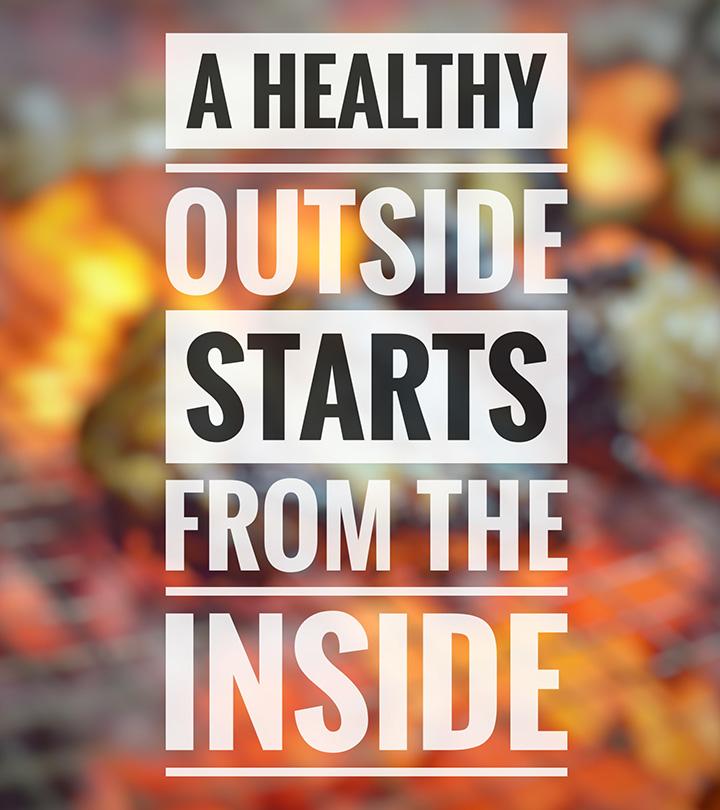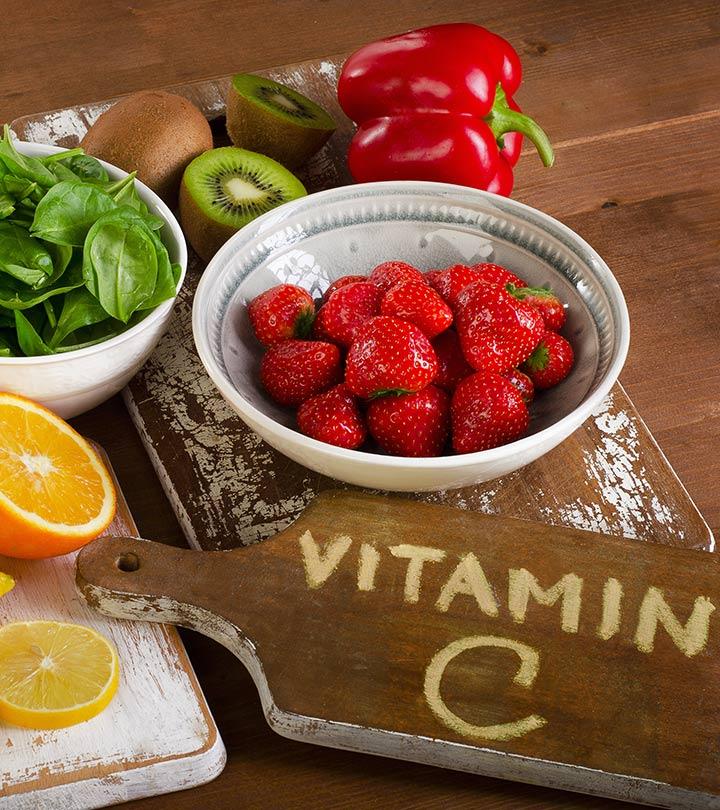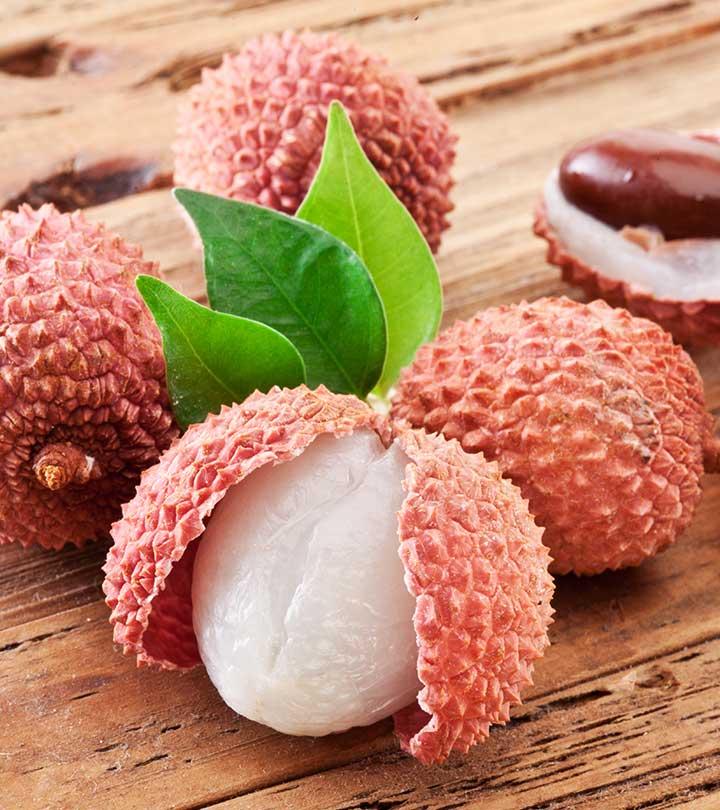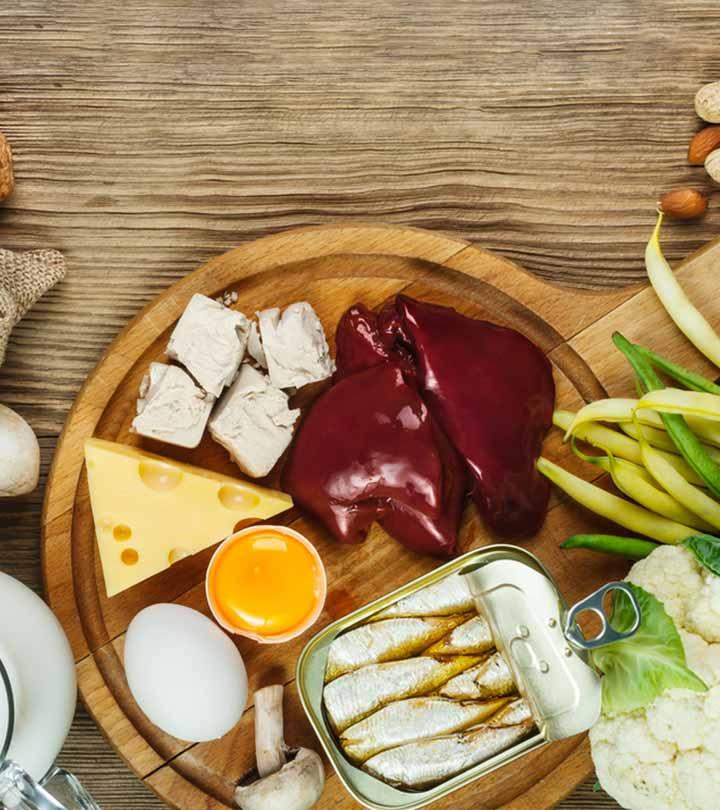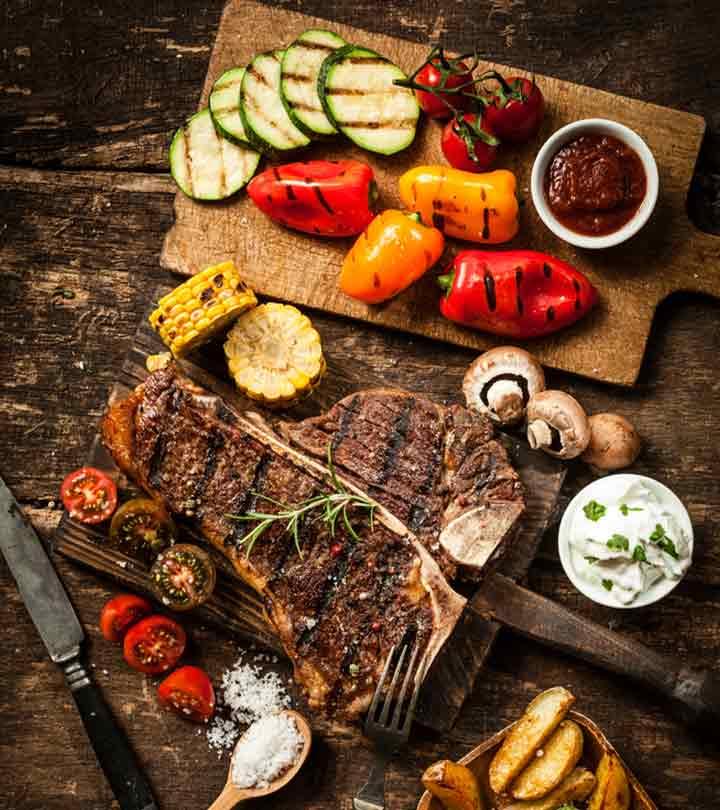29 Healthy Vitamin-D Rich Foods To Add To Your Diet
Mushrooms, beef, ricotta cheese, and more delightful foods to help you up your vitamin D intake.

Image: Shutterstock
Standing in the sun daily to get your daily dose of vitamin D may not be possible every day. But that is where vitamin D-rich foods come into the picture. Unfortunately, many of us have limited information about these foods and may miss out on them in our diet. So, including these foods in your diet will help you in boosting your vitamin D levels. Learn which foods are rich in vitamin D from the post below. Scroll down to know more!
In This Article
What Is Vitamin D?
Vitamin D is a fat-soluble mineral that is formed in the skin when it is exposed to UVB rays in direct sunlight (1). It is a unique vitamin that is essential for a number of functions, including the maintenance of strong bones, muscles, and teeth, cell growth control, proper immune and neuromuscular functioning, and our overall health (2, 3). Vitamin D deficiency can lead to a condition called rickets, where the bones fail to develop and function properly (4).
UV rays are the best natural source of vitamin D (5). They convert a chemical present in your skin into vitamin D3. This is transported to the liver and kidneys and is then transformed to active vitamin D. However, constant exposure to the sun for a long time can increase the risk of developing skin cancer. So, you need limited exposure to the sun to avoid vitamin D deficiency.
 Trivia
TriviaThe downside of this vitamin is that it is not found in many foods. You get a number of food items/products that claim to contain vitamin D, but in reality, they are only fortified with synthetic vitamin D. In fact, there are only a handful of foods high in vitamin d.
We have listed the top 29 foods with vitamin D that are easily available. Check them out!
Top 29 Vitamin D Rich Foods
There are a number of different and healthy vitamin d foods, ranging from naturally occurring ones to supplements. Take a look at the top natural sources of vitamin d:
1. Sunshine
Good news for all the sunshine lovers!
A regular 30-minute stroll in the warm sun can provide you with plenty of vitamin D for the day, which is quite difficult to get otherwise (6). I am talking about direct contact, not the rays that are diffused by the glasses on your windows.
It all happens pretty quickly, particularly during summers. When the sun rays hit our skin, they stimulate the production of vitamin D in the body. The more exposure to the sun, the more the vitamin D production. To boost your vitamin D levels when in the sun, expose at least your face, arms, and hands, or an equivalent area of your body. This is because for vitamin D to be produced, your skin must not be covered in layers. Cast them off till your skin starts turning pink, and you are done with the day’s vitamin D dose.
Don’t be scared, I am not asking you to completely ditch your lifesaver scarves, hats, and gloves. But, dropping them once in a while to get some sunshine seems like a good solution. Never forget to put on a good sunscreen, layers or not.
2. Salmon
Salmon has a high fat content, which makes it an excellent source of vitamin D. Around 3.5 ounces of salmon will provide you with 80% of the recommended dietary amount of vitamin D.
The key is to get salmon that has been caught in the wild or is sustainably farmed. Alaskan salmon contains 5 times more vitamin D than Atlantic salmon, which makes it the better choice. Half a filet of sockeye salmon contains 1400 IU of vitamin D, which is twice the recommended amount you need for a day.
Don’t forget to order a plate of the wonderful salmon today!
3. Supplements
Another way to incorporate vitamin D into your diet is by consuming supplements.
Among the 9,924 Americans who participated in the National Health and Nutrition Examination Survey between 2017 and March 2020, 3.0% of youths and 18.5% of adults reported using vitamin D supplements. 33.9% of youths and 66.9% of adults who reported using vitamin D supplements said they took it regularly for 30 days.
There are two forms of vitamin D supplements – vitamin D2 and vitamin D3. The former, also called ergocalciferol, is synthesized from plants and yeast. This type of vitamin D supplement is most extensively used. The other form of vitamin D supplement is vitamin D3, scientifically known as cholecalciferol. This is the most active form of vitamin D. Since both vitamin D2 and vitamin D3 are not active in the body, they need to be metabolized into an active form in the body, which is called calcitriol.
Caution: Make sure you consult your physician before taking any of the supplements mentioned above to avoid any cases of drug interaction and allergic reactions.
4. Mushrooms
Mushrooms are, in fact, the only plant source containing vitamin D.
This genius grows in sunlight and is great at absorbing sunlight as well, making it a good vitamin D source. Mushrooms are also rich in B-complex vitamins like B1, B2, B5 and minerals like copper.
The amount of vitamin D in mushrooms varies according to the type and variety. Shiitake mushrooms are considered as the best source of vitamin D among all mushrooms.
Always choose mushrooms that are dried in natural sunlight and not by artificial means.
Tip – You can expose raw mushrooms to UV light to boost their vitamin D content. Slice the mushrooms before putting them out. This will help them absorb more UV rays, which will translate to more vitamin D in your food.
5. Mackerels
Another fish variety with good vitamin D content.
Mackerels have high amounts of omega-3 fatty acids. Just 3.5 ounces of mackerel can supply you with 90% of the RDI of vitamin D. Thus, people who consume more of these fish can get those essential minerals and vitamins that the human body cannot produce on its own.
6. Halibut
The firm white meat and sweet flavor of halibut have made it a favorite among fish lovers. This flatfish is a nutritionally dense food and contains important minerals and vitamins like phosphorus, selenium, vitamins B12 and B6, and omega-3 fatty acids. Halibut is also one of the best sources of vitamin D, and 100 grams of halibut fish contains 1097 IU of the sunshine vitamin.
7. Herring
Herring fishes contain a significant amount of vitamin D as they feed on plankton, which is full of vitamin D.
These shiny gray fish are consumed pickled, smoked or creamed. Herring contain healthy fats and other important nutrients, which make them a wise addition to your diet. They are also an excellent source of protein, which promotes muscle development, and contain high amounts of vitamin B12, selenium, phosphorus, calcium, and iron.
8. Cod Liver Oil
Cod liver oil has been a popular supplement for many years and is extremely rich in vitamin D, vitamin A, and omega-3 fatty acids.
Consuming this oil regularly will promote healthy and strong bones, prevent osteoporosis in adults, and improve brain activity.
Tip – Cod liver oil is also available in the capsule form, which is the best option for those who don’t like its strong aroma.
9. Caviar
Caviar is a common ingredient used in sushi, and it provides 232 IU of vitamin D per 100-gram serving.
This is a grainy textured fish that has a luscious taste and is a wonderful appetizer. It is a storehouse of nutrients and contains minerals like selenium, iron, magnesium, calcium, and phosphorus. It also contains essential vitamins like vitamin A, vitamin K, vitamin B6, folates, riboflavin, and pantothenic acid.
10. Sardines
Sardines are becoming more and more popular due to their amazing health benefits. They are one of the best sources of vitamin D.
Just a small amount of sardines will fulfill 70% of your recommended dietary allowance of vitamin D. This fish offers 270 IU of vitamin D per 100 grams. They are also a great source of vitamin B12, omega-3 fatty acids, protein, and selenium. The high omega-3 fatty acid content contributes to better bone health, lowers cholesterol, and reduces inflammation.
11. Catfish
Catfish, like herring, constantly feed on plankton and minuscule sea life that creates vitamin D from sunlight.
They are low in calories and contain vitamins, protein, and good fats. Just one fillet provides you with 200% of the recommended daily value of vitamin D, and 159 gram of catfish provides you with 795 UI of vitamin D.
12. Canned Tuna
Three ounces of tuna provides 50% of the vitamin D your body needs.
Fresh and wild-caught tuna is the most nutritious. Moreover, eating oily fish that lubricates the body also provides other health benefits like better memory and proper brain function. Light tuna has the maximum amount of vitamin D, and it has lesser mercury than white tuna.
13. Sole/Flounder Fish
Sole and flounder are flatfish that contain one-fourth of the daily required amount of vitamin D. Pacific flounder and sole fish are best for consumption.
14. Beef Liver
Beef liver is a good source of vitamin D; and 3 ounces of beef liver contains 42 IU of vitamin D, around one-fourth of the daily vitamin D requirement.
Beef is also a good source of vitamin B12, iron, and protein. Grass-fed beef is best for consumption as it contains a good amount of all essential nutrients. It also contains protein and thiamin.
15. Ricotta Cheese
Ricotta cheese stands out as the only source of vitamin D among all milk by-products. It contains five times more vitamin D than other cheese.
It contains a relatively high amount of vitamin D, around 25 IU per serving.
16. Carp Fish
Carp fish are also a good source of vitamin D. Did you know that 100 grams of the fish contain 988 IU of vitamin D?
Apart from vitamin D, this fish also contains vitamins A, D, E, and K, niacin, riboflavin, and minerals like zinc, copper, magnesium, and sodium.
17. Eggs
Eggs contain vitamin D in small amounts.
Including one egg daily in your diet will provide you with 10% of the recommended dosage of vitamin D. Pasture-raised hens spend a lot of time outdoors. Hence, their eggs have the highest amount of vitamin D as compared to the other eggs in the market.
Besides vitamin D, eggs are also a good source of vitamin B12 and protein.
18. Salami
Salami provides 62 IU of vitamin D per 100 grams while sausages provide 55 IU of vitamin D per 100 grams.
Note: Though salami, ham, and sausages are good sources of vitamin D, they contain a high amount of sodium and can increase the cholesterol levels. Excess of salami and ham can increase the risk of stroke, hypertension, and heart attack.
19. Cereal
Some forms of cereals also contain vitamin D.
Before buying cereals, check the nutritional value on the label to get an idea about the percentage of vitamin D content. Choose the ones that contain at least 100 IU of vitamin D. All bran cereals provide 131 IU of vitamin D, while fruit-flavored cereals provide 11 IU of vitamin D.
20. Milk
One glass of milk will provide 20% of your daily requirement of vitamin D.
Skimming of milk removes vitamin D as it is a fat-soluble vitamin. So, always opt for whole fat milk. However, nowadays, skimmed milk is also fortified with vitamin D to ensure you don’t miss out on this important nutrient.
Keep in mind that dairy products like cheese, yogurt, and ice cream do not contain vitamin D or fortified vitamin D. Only fluid milk and products made from whole milk contain this nutrient.
 Trivia
Trivia21. Oysters
Oysters are one of the best vitamin d rich foods.
Raw, wild-caught oysters contain 320 IU of vitamin D per 100 grams – a whopping 80% of our daily requirement. In addition, oysters are also a good source of vitamin B12, zinc, iron, manganese, selenium, and copper.
Though raw oysters have a higher nutritional value, one should properly cook them before eating to destroy the harmful bacteria present in them.
Note: Oysters are high in cholesterol and should be consumed in moderation, especially by people suffering from cardiovascular ailments.
22. Orange Juice
One of the best vitamin D fruits. A glass of fresh orange juice is the best way to start your day. You can also consider packaged juices if fresh fruits are not available. This is perfect for those who dislike dairy products.
Packaged orange juice is equipped with good amounts of vitamin D. One cup of orange juice contains 100 IU vitamin D and 120 calories.
23. Soy Products
Every 79-gram serving of tofu offers 581 IU of vitamin D. One cup of plain light soya milk provides 338 IU of vitamin D while soy milk fortified with calcium and vitamins A and D provides 297 to 313 IU. You can also try soy yogurt as it offers 161 IU of vitamin D.
24. Shrimp
Every 85 grams of shrimp contains 139 IU of vitamin D. It has moderate amounts of omega-3s, protein, selenium, antioxidants, and less fat. You can indulge in this seafood without worrying about your weight.
25. Margarine
Margarine spreads are fortified with vitamin D, which makes them a delicious option.
Being one of the vitamin d rich foods, it is a healthier alternative to normal butter as it contains 65% less saturated fats than butter. Margarine also contains moderate amounts of omega-3 fatty acids and monounsaturated fats, which make it a good option for breakfast.
26. Vanilla Yogurt
Having a cup of vanilla yogurt is the perfect option for those who do not want to go for any of the meaty treats. Yogurt is good for your taste buds as well as health.
Each serving of vanilla yogurt is known to contain 115 IU of vitamin D. A considerable amount, I say. Choose a brand that is fortified with vitamin D to get 20% of the daily requirement of vitamin D.
Note: This option can be quite a ‘no-no’ for weight watchers, considering that every cup of vanilla yogurt contains about 208 calories.
27. Butter
Good news for all the butter enthusiasts! While it is typically frowned upon by dieters, this ‘fatty’ food is known to contain a small amount of vitamin D.
Butter is saturated fat, and it is essential to aid the absorption of antioxidants and vitamins by the body. It also assists in the absorption of vitamin D obtained from other sources.
Always remember that quantity is the key. Don’t go overboard with butter. When consumed in moderation, it can actually be a healthy addition to your diet.
28. Sour Cream
Sour cream, apart from giving a tasty twist to snacks, is also known to contain vitamin D.
This dip can be added to your diet to extract most of its health benefits. Sour cream is a rich source of essential nutrients like proteins, vitamin A, potassium, and calcium. And, what’s more? Every tablespoon of sour cream contains just 28 calories. Healthier than expected, isn’t it?
29. Swordfish
With the number of fish items included in this list, it’s quite obvious that there isn’t any other source that can beat fish in terms of the amount of vitamin D they provide. Apart from those sun rays, of course! Swordfish is another addition to the list.
This delicious variety, in addition to containing various health benefits, is known to provide you with cent per cent vitamin D (about 566 IU) with every 3-ounce serving. Go ahead and try it today!
So, that was all about what foods have vitamin d. Keep reading to know more about vitamin D and the factors that influence its production.
The Recommended Dose Of Vitamin D
The Recommended Daily Allowance (RDA) of vitamin D is measured in international units (IU). According to the data published in 2010, the RDA of vitamin D is 600 IU for people aged between 1-70 years. Infants, on the other hand, are recommended to take 400 IU of vitamin D per day. Pregnant and breastfeeding women need to have 600-2000 IU daily, depending on their health conditions. Similarly, for people aged over 71 years of age, this RDA changes to 800 IU and up.
Risk Factors Of Low Vitamin D Levels
Vitamin D plays a vital role in many functions in the human body. Hence, low levels can pose many risks.
- Inadequate vitamin D may weaken the bones, increasing the risk of fractures and osteoporosis (8).
- Low levels of vitamin D may contribute to muscle weakness and pain and slow down recovery (8).
- Vitamin D deficiency can weaken your immune system and make you prone to disease (9).
A blogger recalls her personal experience of dealing with multiple sclerosis (a chronic pain, autoimmune disorder) by enhancing the intake of vitamin D, under strict medical supervision. She shares her views of her sixth month of being on the treatment, noting, “Dr.Pellegrini has increased my daily dosage from 90 000 IU to 110 000 IU of vitamin D per day since we still have not the desired value of PTH hormone. After 6 months I am still alive and there are no signs of vitamin D toxication (i).”
- Insufficient vitamin D is associated with mood disorders and an increased risk of depression (10).
- Some studies suggest a link between low vitamin D and heart health issues (11).
Factors That Influence The Production Of Vitamin D In Your Skin
The amount of vitamin D produced in your body isn’t dependent only on the type of food consumed or the amount of time spent in the sun. This process is highly specific and depends on factors that have no connection to your diet or behavior, like your physical and genetic structure. Take a look:
1. Skin Color And Tan Level
Ever wondered why light skinned people are at more risk of UV exposure and skin cancer? It is because of their melanin content. And this fact is also important in the production of vitamin D.
Those with pale skin reach the equilibrium point of vitamin D production roughly after 15-20 minutes of exposure. Any further exposure will cause harm.
This time span is doubled or even tripled in the case of dark skinned people, of course, depending on the melanin levels.
So, if you fall into the first category, expose yourself to the sun for 15 minutes or less, with only a few clothes on. Using a tanning bed is an option, but avoid it if you can.
Those who fall into the second category can be outside for a longer time. But don’t overdo it. Quit the process as soon as you witness your skin turning a light pink.
2. Time Spent In The Sun
The amount of time you spend directly in the sun is also an important factor.
Those who spend relatively lesser time outside are more likely to have vitamin D deficiency compared to others. But, as explained earlier, this totally depends on your skin type and color. Don’t stay out in the sun for more than the required duration. It might cause burns and even lead to skin cancer.
Your body is not a machine. It will only produce a limited amount of vitamin D per day, even if you spend the entire day in the sun.
To know if you have received your quota of vitamin D for the day, look at your skin. If it has turned pink, you are done. While tan is good, don’t let it harm your skin.
3. Weather Conditions
Weather also plays an essential role in determining how much vitamin D your body can produce.
Cloudy days, though relatively cool, are highly deceptive. You may not know this, but even cloudy days can cause sunburns. This is because though the clouds block the infrared rays, they can only filter some UV rays but can’t block them entirely.
Also, snow, sand, and water reflect the UV radiation, increasing its intensity, regardless of whether the weather is clear or not. UV penetration is reduced to a low level in areas with air pollution like cities that are surrounded by hills.
4. Latitude And Altitude
Some geography for you, folks.
I suppose you know the sun’s radiation is the strongest at the equator and reduces as we go towards the poles. Therefore, the UV radiation is as much as 4 to 5 times in the areas that fall on the equator when compared to the Antarctic and Arctic circles.
This effect is also at its peak at higher altitudes when compared to plains and seas as there is much less atmosphere to absorb it. It might sound absurd, but you are at more risk of sunburns at mountains than at plain ground.
5. Season
This is, by far, the most obvious factor associated with UV radiation. Summers mean more sun, which means more vitamin D. But, take care of your vitamin D levels during the winters as it drops as much as 50% during this time of the year. So, go ahead, take a sunbath.
6. Time Of The Day
The time of the day is equally important. The optimal time to take a sunbath is between 7 AM-9 AM.
This time is perfect as even a short exposure to UV rays can provide you with enough vitamin D for the day.
A Word Of Caution
Overdose of anything can cause adverse effects, and this previtamin is no exception. Its overdose can cause a number of conditions including nausea, poor appetite, constipation, weight loss, weakness, and kidney damage.
These conditions generally occur when you intake an excess of vitamin D supplements. Be aware of the supplements that carry active ingredients.
One should not take more than 4000 IU per day, whether it is through exposure to the sun, food items, and/or supplements.
Infographic: Top 5 Nutritious Foods That Are High In Vitamin D
Vitamin D is essential for calcium absorption and better bone health. The sun is the ultimate source of this fat-soluble vitamin. However, standing in it every day to get your daily dose of the vitamin isn’t feasible. In such a case, including foods high in vitamin D in your diet is the best solution. Check out the infographic below to learn about the best vitamin D-rich foods you can consume.

Illustration: StyleCraze Design Team
Vitamin D is known to be beneficial for our bone and teeth health. Especially growing children, women, and aging people need a good amount of vitamin D to keep their bones strong and healthy. Also known as sunshine vitamin, it may not also be possible to get enough vitamin D solely from sun exposure, given the location and weather changes. So a vitamin-D rich diet plays an important role in maintaining the balance. Mushrooms, eggs, salmon, sardines, and a few other fish and dairy food options listed above can help you get enough vitamin D. Supplements and fortified foods, milk, and cereals are also a common way to keep your vitamin D levels at par. Having a balanced vitamin-D rich diet with regular exercise would help keep you fit and active for long.
Stay fit, stay healthy!
Frequently Asked Questions
Are potatoes high in vitamin D?
No, potatoes do not contain vitamin D. However, they are loaded with other nutrients like iron and B vitamins, which aid in oxygen transport and metabolism.
What are the signs of low vitamin D?
Fatigue, depression, muscle weakness, pain, low energy, and anxiety are signs of low vitamin D levels.
Does broccoli have vitamin D?
No, broccoli does not contain vitamin D. However, it is filled with other major nutrients like calcium and vitamins A and K that help promote overall health.
Do almonds have vitamin D?
Fortified almonds are high in vitamin D. In their natural form, they have nutrients like vitamin E, magnesium, calcium, and copper.
Key Takeaways
- The immune system and bone health both benefit from vitamin D.
- Fatty fish, egg yolks, mushrooms, fortified dairy, and grain products are among foods high in vitamin D.
- In addition to pills, sunshine exposure is another way to get vitamin D.
- A daily dosage of 600–800 IU of vitamin D is suggested.
- People with little sun exposure, dark skin, and particular medical problems are at risk for vitamin D insufficiency.

Image: Dall·E/StyleCraze Design Team
Discover the top 10 richest vitamin D foods! Learn how to incorporate these healthy foods into your diet and get the most out of your meals. Watch this video!
Personal Experience: Source
StyleCraze's articles are interwoven with authentic personal narratives that provide depth and resonance to our content. Below are the sources of the personal accounts referenced in this article.
i. The 6th monthhttps://mscurevitamind.wordpress.com/2015/11/08/the-6th-month/
Read full bio of Dr. Ramon Andrade de Mello
Read full bio of Arshiya Syeda
Read full bio of Moksha Gandhi

















